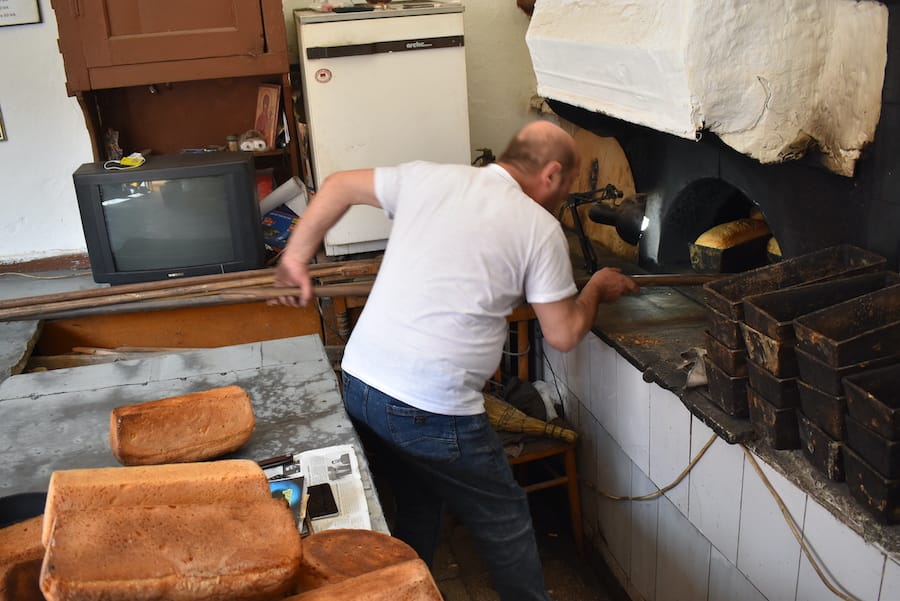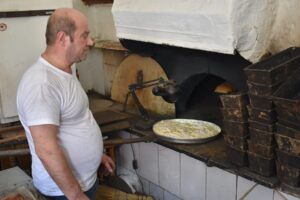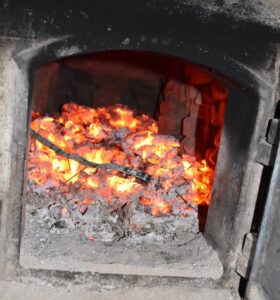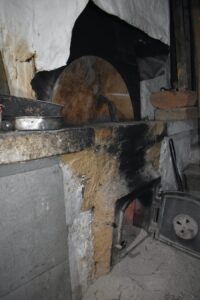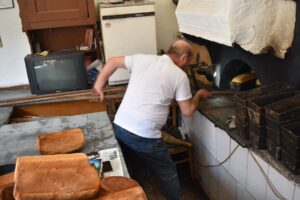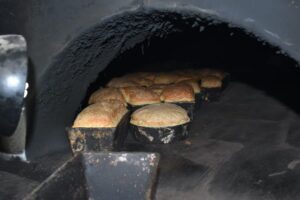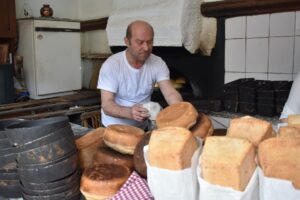A wood-fired oven is a traditional oven, in which bread, communion wafer, and various pies have been constantly baked, to mention a few of them: lakror (two-layer savory pie), pastiçe (pasta dish), stuffed peppers casserole, meat, fish, various desserts, and so on.
The baking process is a common practice because bread is a daily consumed product. Meanwhile, baking other dishes is less often practiced, mostly on festive occasions, such as Christmas, New Year, and the like. Baking of various pies and desserts in day-to-day life is a choice of the day dish people themselves make and take to the bakers.
The baking process goes through these steps: First, the baker lights the oven about 2 (two) hours before it is ready for baking so that the oven walls are heated up at the required temperature. Materials used for burning are usually beams saved from old houses given their lower cost, or when these are not at disposal, even wood logs and chips. The latter requires a person to consistently deal with their burning so as to keep it under control.
Small pieces of kindling are stacked into the hearth of the cooking chamber and then lit. Based on my own experience, the baker is aware of when the proper temperature is reached and the number of hardwood logs to be used. Once the oven is heated, different dishes such as bread, communion wafer, various pies and casseroles, and so on, are placed in for baking.
Dishes with a stronger smell, such as meat or fish are baked in the oven separately, i.e. not with bread or other dishes. Temperature control is achieved by:
– collecting and leveling off embers in the cooking chamber,
– opening or closing the two cartridge-shaped gears (these are two holes across the center of the baking oven floor, each with a metal lid. These lids are opened or closed to regulate the heat required).
Bread and communion wafers are placed in pre-arranged aluminum containers, which come in different shapes and sizes. In contrast, cooking pans are placed in the oven as brought by the people themselves, prepared in their aluminum, stainless steel, or ceramic pans.
Since the oven is large and heated, cooking is done with shovels/peels. They feature in metal material with a long hardwood handle to reach the furthest point of the oven. As soon as all baking dishes are poked in, the oven door is closed and left as long as needed. By the time dishes have been baked, the oven door is opened to check the baking process. Those dishes appearing more baked are put further aside, while those still needing to be baked are pushed to the center. When the oven temperature drops and more heat is needed, the lids of cartridge-like gears are opened. When it is too hot, the lids are kept closed. To check the baking process, the baker uses a flashlight positioned in the opening at the front of the oven.
The oven walls are made from a chamotte bricks layer, with the top built-in dome shape design of ovenproof bricks. Above the cooking chamber, two slabs are fitted with a space in between, into which salt is sprinkled to better retain the heat. The lower slab is made from ovenproof bricks, while the upper slab is a pumice stone. The wood-fired oven can be operated all day long. In the morning, typical dishes that require a higher temperature come first, while later, as the temperature drops down, dishes that require a lower temperature can be put in, amongst them various desserts, baklava, meringues, and so on.
Once the baking process has finished, the dishes are placed on the counter to cool down. The baker gets grip of pans holding bread loaves and takes them out using the shovel and covers them with napkins as they are very hot. They are reverted on the counter so that the bread loaves come out and are stacked one on top of the other. As soon as slightly cooled down, the loaves are orderly placed on wooden shelves.
When the baking process has finished and when the oven cools down, the baker cleans it with a tool made from a stick and a swab-like material, which is called pepellashkë (long-handled bristle or wire brush).

